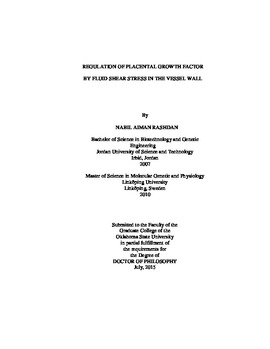| dc.contributor.advisor | Lloyd, Pamela G. | |
| dc.contributor.author | Rashdan, Nabil Aiman | |
| dc.date.accessioned | 2016-09-29T18:42:31Z | |
| dc.date.available | 2016-09-29T18:42:31Z | |
| dc.date.issued | 2015-07 | |
| dc.identifier.uri | https://hdl.handle.net/11244/45304 | |
| dc.description.abstract | Arteriogenesis is the process by which mature arteries form from collateral arterioles after upstream arterial stenosis or occlusion. During collateral remodeling, monocytes are recruited to the vessel wall. Placental growth factor (PLGF) is a potent stimulator of arteriogenesis via monocyte recruitment. Although fluid shear stress (FSS) is thought to be the primary signal for arteriogenesis, its role in regulating PLGF expression is unknown. However, PLGF is increased in collaterals by upstream arterial ligation. Therefore, we hypothesized that PLGF expression is regulated by FSS. To test this hypothesis, we created an in vitro model of coronary vessels, consisting of human coronary artery endothelial cells (HCAEC) and human coronary artery smooth muscle cells (HCASMC) cocultured on porous Transwell inserts. We used a cone and plate apparatus to expose the HCAEC of the coculture to different FSS waveforms. We also employed an ex vivo model consisting of isolated mesenteric arterioles perfused at various flow rates. Flow or FSS significantly increased PLGF expression at both the mRNA and protein level, and this effect was dependent on the duration and magnitude of FSS, confirming our hypothesis. PLGF was predominantly produced by HCAEC, but HCASMC also played a role in modulating HCAEC PLGF expression and response to FSS. Next, we set out to identify the signaling pathways mediating the effects of FSS on PLGF. Hydrogen peroxide and NADPH oxidase 4 were required for FSS to upregulate PLGF. Similarly, heme oxygenase 1 activity was also required for FSS to affect PLGF expression. Heme oxygenase 1 also mediated the effects of hypoxia on PLGF, and our studies suggest the existence of a common pathway between these two stimuli (FSS and hypoxia). This study builds on several recent studies using various redox knockout mice to study vascular remodeling. It further emphasizes the importance of PLGF for arteriogenesis and presents a novel possible mechanism by which arteriogenesis progresses. | |
| dc.format | application/pdf | |
| dc.language | en_US | |
| dc.rights | Copyright is held by the author who has granted the Oklahoma State University Library the non-exclusive right to share this material in its institutional repository. Contact Digital Library Services at lib-dls@okstate.edu or 405-744-9161 for the permission policy on the use, reproduction or distribution of this material. | |
| dc.title | Regulation of placental growth factor by fluid shear stress in the vessel wall | |
| dc.contributor.committeeMember | Hinsdale, Myron E. | |
| dc.contributor.committeeMember | Lacombe, Veronique A. | |
| dc.contributor.committeeMember | Gappa-Fahlenkamp, Heather | |
| osu.filename | Rashdan_okstate_0664D_14253.pdf | |
| osu.accesstype | Open Access | |
| dc.type.genre | Dissertation | |
| dc.type.material | Text | |
| thesis.degree.discipline | Veterinary Biomedical Sciences | |
| thesis.degree.grantor | Oklahoma State University | |
